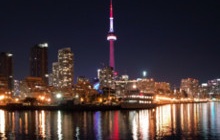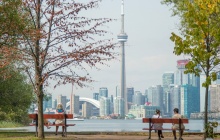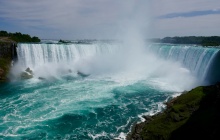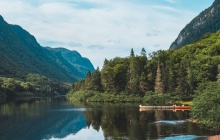Eastern Canada's must-sees, from Toronto to Quebec city
TORONTO > NIAGARA > 1000 ISLAND > MONTRÉAL > JACQUES CARTIER > SAGUENAY> TADOUSSAC>LA MALBAIE > QUÉBEC //
Itinerary
-
Day 1 Toronto
 According to the flight arrival time, you will make your first discoveries of the "Ville Reine" (Queen City). Toronto is the provincial capital of Ontario and one of Canada's largest cities. This cosmopolitan city with its relaxing atmosphere will certainly seduce you.
According to the flight arrival time, you will make your first discoveries of the "Ville Reine" (Queen City). Toronto is the provincial capital of Ontario and one of Canada's largest cities. This cosmopolitan city with its relaxing atmosphere will certainly seduce you.
- Accommodation: Hotel
-
Day 2 Toronto
 A day to discover the many facets of the city. This can be discovered on foot, by bike, and why not by kayak for a panoramic view of the city's emblematic skyline.
A day to discover the many facets of the city. This can be discovered on foot, by bike, and why not by kayak for a panoramic view of the city's emblematic skyline.
- Accommodation: Hotel
-
Day 3 Toronto / Niagara Falls / Toronto
 Pick up your rental vehicle and drive to Niagara Falls, which will impress you with the strength of their flow (168,000 cubic meter per minute). **Optional: put on your raincoat and get a closer look at the strength of these falls during a cruise.
Pick up your rental vehicle and drive to Niagara Falls, which will impress you with the strength of their flow (168,000 cubic meter per minute). **Optional: put on your raincoat and get a closer look at the strength of these falls during a cruise.
- Included activity: boat cruise at Niagara Falls
- Accommodation: Hotel
- Transportation: approx. 162 mi, approx. 3h -
Day 4 Toronto / 1000 islands
 Let’s go to Kingston, a city steeped in history on the banks of Lake Ontario, which is the gateway to the archipelago of 1000 islands. Rich in heritage, culture and activity, you will not fail to visit important historical sites such as Fort Henry and Bellevue House.
Let’s go to Kingston, a city steeped in history on the banks of Lake Ontario, which is the gateway to the archipelago of 1000 islands. Rich in heritage, culture and activity, you will not fail to visit important historical sites such as Fort Henry and Bellevue House.
- Accommodation: Hotel
- Transportation: approx. 162 mi, approx. 3h -
Day 5 1000 Islands / Montreal
 TheThousand Islands is a group of islands made up of granite and pine trees located in a transition area between the St. Lawrence River and Lake Ontario. Take a shuttle to one of the park's islands, have fun exploring the hiking trails or take a cruise to enjoy the landscape while being comfortably seated. After this amazing discovery of nature, you will drive to Montreal, the french metropolitain city.
TheThousand Islands is a group of islands made up of granite and pine trees located in a transition area between the St. Lawrence River and Lake Ontario. Take a shuttle to one of the park's islands, have fun exploring the hiking trails or take a cruise to enjoy the landscape while being comfortably seated. After this amazing discovery of nature, you will drive to Montreal, the french metropolitain city.
- Accommodation: Hotel
- Transportation: approx. 180 mi, approx. 3h30 -
Day 6 Montreal
 Discover the charms of this multi-cultural city. Stroll along the Old Port, with its cobblestone streets, artists and views of the St. Lawrence River. Immerse yourself in North American culture, amidst the skyscrapers. Don't miss the "Arti" district on the Plateau, with its colorful houses. Round off your visit with a stroll to the top of Mont Royal, where you can overlook the city at sunset. Breathtaking!
Discover the charms of this multi-cultural city. Stroll along the Old Port, with its cobblestone streets, artists and views of the St. Lawrence River. Immerse yourself in North American culture, amidst the skyscrapers. Don't miss the "Arti" district on the Plateau, with its colorful houses. Round off your visit with a stroll to the top of Mont Royal, where you can overlook the city at sunset. Breathtaking!
- Accommodation: Hotel
-
Day 7 Montreal / Mauricie National Park
 Have a stroll in Montreal in the morning before taking the road to the well-known Mauricie national park.
Have a stroll in Montreal in the morning before taking the road to the well-known Mauricie national park.
- Accommodation: Hotel
- Transportation: approx. 100 mi, approx. 2h30 -
Day 8 Mauricie National Park
 Explore the magnificent Mauricie Park. Hike, canoe or raft your way through an unforgettable experience in Quebec's wilderness! At the end of the day, enjoy an unforgettable encounter with the region's bears with a local guide who will teach you more about these emblematic Canadian animals.
Explore the magnificent Mauricie Park. Hike, canoe or raft your way through an unforgettable experience in Quebec's wilderness! At the end of the day, enjoy an unforgettable encounter with the region's bears with a local guide who will teach you more about these emblematic Canadian animals.
- Included activity : bear watching with local guide
- Accommodation: Lodge -
Day 9 Mauricie national park / Lac Saint Jean
 A day's drive to reach the shores of Lac St-Jean, but not just any road! The portion of Route 155 between Grandes Piles and La Tuque is spectacular, offering unique views of the rivière Saint-Maurice.
A day's drive to reach the shores of Lac St-Jean, but not just any road! The portion of Route 155 between Grandes Piles and La Tuque is spectacular, offering unique views of the rivière Saint-Maurice.
- Accommodation: Cabin
- Transportation: approx. 130 mi, approx. 2h15 -
Day 10 Lac Saint Jean
 Experience the vastness of Lac Saint-Jean. Are you a water sports enthusiast or a hiker? Whatever your desire of the day, you will inevitably find your happiness in the host of activities offered on the site.
Experience the vastness of Lac Saint-Jean. Are you a water sports enthusiast or a hiker? Whatever your desire of the day, you will inevitably find your happiness in the host of activities offered on the site.
- Included activity : Zoo St-Félicien
- Accommodation: Cabin -
Day 11 Lac Saint Jean / Saguenay
 On the way to the Parc National du Fjord-du-Saguenay. The only navigable fjord in North America, it is home to more than 16 marine species typical of the Arctic. A breathtaking landscape.
On the way to the Parc National du Fjord-du-Saguenay. The only navigable fjord in North America, it is home to more than 16 marine species typical of the Arctic. A breathtaking landscape.
- Accommodation: Cabin
- Transportation: approx. 68 mi, approx. 1h20 -
Day 12 Saguenay
 Via Ferrata, does this word mean anything to you? It would be a mistake to miss this activity by being there. Hang on to climb the rock to the Bridge and prepare to cross the void on an 262ft long suspension bridge!
Via Ferrata, does this word mean anything to you? It would be a mistake to miss this activity by being there. Hang on to climb the rock to the Bridge and prepare to cross the void on an 262ft long suspension bridge!
- Accommodation: Cabin
-
Day 13 Saguenay / Tadoussac / La Malbaie
 Head to Tadoussac, a maritime crossroads composed of the fleuve Saint-Laurent and the Saguenay Fjord. It is the ideal place to go and meet the whales. A word of advice: take part of a boat cruise that will allow you to get closer to it without disturbing them. After this experience, continue on the the Charlevoix region, well-know for its delicious local gastronomy.
Head to Tadoussac, a maritime crossroads composed of the fleuve Saint-Laurent and the Saguenay Fjord. It is the ideal place to go and meet the whales. A word of advice: take part of a boat cruise that will allow you to get closer to it without disturbing them. After this experience, continue on the the Charlevoix region, well-know for its delicious local gastronomy.
- Included activity : whale watching by boat
- Accommodation: Ready-to-camp
- Transportation: approx. 143 mi, approx. 3h15 -
Day 14 La Malbaie
 Mandatory stop at Parc national des Hautes-Gorges-de-la-Rivière-Malbaie and its more than 100 km of hiking trails. And why not challenge the river currents on a rubber dinghy?
Mandatory stop at Parc national des Hautes-Gorges-de-la-Rivière-Malbaie and its more than 100 km of hiking trails. And why not challenge the river currents on a rubber dinghy?
- Accommodation: Ready to camp
-
Day 15 La Malbaie / Québec city
 Let yourself be seduced by the narrow cobbled streets of Quebec City. The picturesque old town is also a World Heritage Site of UNESCO. You will not be able to miss the Château Frontenac which overlooks the top of the city.
Let yourself be seduced by the narrow cobbled streets of Quebec City. The picturesque old town is also a World Heritage Site of UNESCO. You will not be able to miss the Château Frontenac which overlooks the top of the city.
- Accommodation: Hotel
- Transportation: approx. 87 mi, approx. 1h50 -
Day 16 Québec city / Montréal
 The time for the return flight has come. You can drop off your rental car directly at the airport.
The time for the return flight has come. You can drop off your rental car directly at the airport.
- Transportation: approx. 171 mi, approx. 3h
Period & budget
When to travel?
The best period for travelling is during the following months:
| Jan | Feb | Mar | Apr | May | Jun | Jul | Aug | Sep | Oct | Nov | Dec |
Price
The budget is an indication of the price per person, subject to availability. Your local agent will send you a customized quote with the exact price. The price can vary according to availability, level of services, period of travel, number of participants, booking time frame and other items.
Included
- 14 nights' standard accommodation
- 14-day rental of a mid-size Hyundai Elentra or equivalent, unlimited mileage, LDW and ALI insurance, local taxes, airport fees, one tank of gas and an additional driver
- The following activities: Niagara Falls cruise (20 min), bear watching with a local guide (1h30) , whale watching cruise in Tadoussac (2h)
- Roadbook (electronic version)
- Canadian taxes (federal and provincial)
- 24-hour assistance
- Meals mentioned: 2 breakfasts
Not included
- International flights (available on request)
- Gasoline
- Personal expenses
- Meals not mentioned
- Beverages (except tea and coffee for included meals)
- Entrance fees to national parks
- Optional activities not mentioned
- Travel insurance
International flights
Terms and conditions
Booking conditions
Invoice procedure
Cancellation policy
If cancellation occurs:
- More than 31 days before departure: 20% of the total booking amount (excluding insurance and fixed fees)
- Between 30 and 21 days before departure: 35% of the total booking amount (excluding insurance and fixed fees)
- Between 20 and 14 days before departure: 50% of the total booking amount (excluding insurance and fixed fees)
- Between 13 and 7 days before departure: 75% of the total booking amount (excluding insurance and fixed fees)
- Less than 7 days before departure: 100% of the total booking amount (excluding insurance and fixed fees)
Regardless of the cancellation or contract modification date, the following fees are added to the standard cancellation terms above:
- Airfare fees: If your flight ticket has to be issued well in advance—often to secure the best fare—100% of the non-refundable flight costs will be charged in case of cancellation or change. In this case, the standard cancellation terms apply only to the land portion of the trip.
- Land service fees: Any non-refundable fees incurred early for firm bookings will be charged in case of cancellation.
- Insurance: Whether you purchased multi-risk or cancellation insurance, the insurance premium is non-refundable under any circumstances.
The date the written notice is received will be considered the official cancellation date and will determine the applicable cancellation fees.
Altaï Canada may also cancel a trip due to exceptional circumstances considered force majeure (e.g., volcanic eruptions, social unrest, strikes, severe weather) that could compromise the safety of participants. In such cases, all amounts paid will be fully refunded, but no additional compensation can be claimed.
Changes to travel contract
Pricing
Contract transfer
Insurance
Practical info
Staff
- A day by day (itinerary) description
- Destination description
- Useful tips on driving
- Cities and parks maps
- Activities description
Food
Accommodation
Transportation
Budget & exchange
Tips
Supplied equipment
Luggage
Passport
Health information & recommendations
Weather
Electricity
Local time
Topography
Sustainable tourism
- A fair economical repartition
- The improvement of local teams’ working conditions and their awareness of the protection of the environment
- The information of travelers about respecting the local population and environment and the collection of their feelings at their return.
- Avoid letting waste out, throw it in the trash can or bring it with you
- Use potable water sparingly (take a shower instead of a bath and report any leaks) and avoid wasting it (use biodegradable soap to wash yourself)
- Avoid damaging cultural sites: don’t touch the statues, don’t move the stones and objects
- Exchange instead of giving (too Important gifts can destabilize the local economic stability of the country depending on their living standards)
- When taking a walk, especially in some fragile ecosystems, observe the fauna from afar, do not go beyond beaten roads, limit stamping and do not bring any souvenirs: give up picking rare flowers picking fossils...
- In some hotels, you can have individual air conditioning. It is advised to systematically switching it off when you’re out of the room to avoid energetical overconsumption and greenhouse gas emission.


